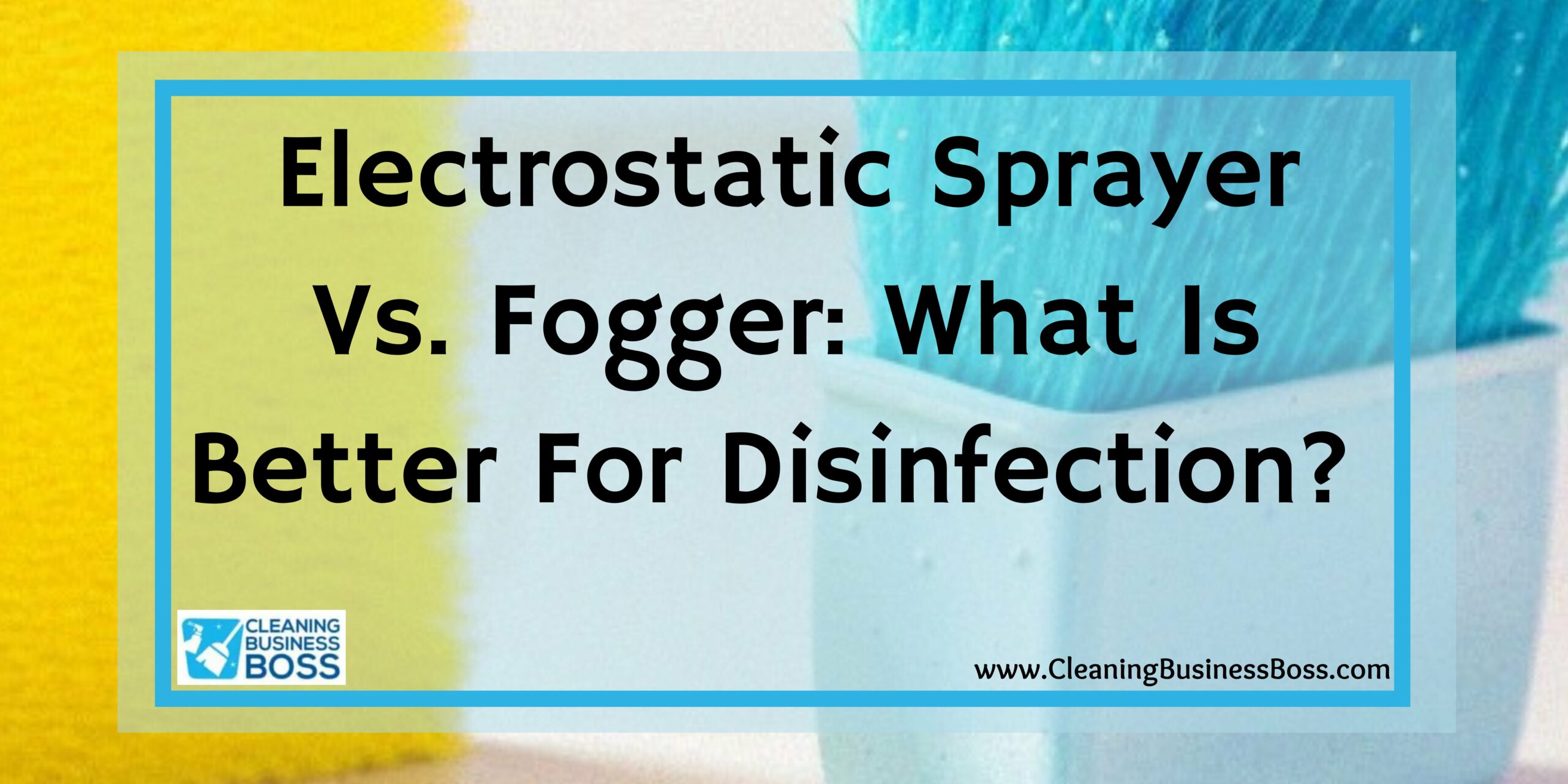Disinfecting is the most important of all cleaning tasks. What makes disinfecting so important? Caswell Medical states that the purpose of disinfection is to kill and remove microscopic organisms from surfaces. The disinfecting process is also essential to stopping the spread of viruses such as the common cold and the flu. I don’t know about any of you, but I don’t feel like I have finished cleaning until I have disinfected every imaginable surface area.
Electrostatic sprayers are better for disinfection over foggers for four important reasons:
- Shorter waiting periods
- Less exposure to harmful chemicals
- They have more surface coverage
- They are more cost-effective
I am going to break down five essential categories that compare electrostatic sprayers and Foggers. I will give the advantages and disadvantages of both disinfection methods, declaring a winner for each category. At the end of this article, I will declare a winner between electrostatic sprayers and Foggers by choosing the method of disinfection that wins the most categories in the debate.
How Do They Work?
Per The Janitor Store, electrostatic sprayers contain an electrode that positively charges the cleaning solution. Per CMM Online, electrostatic sprayers work by charging liquids as they pass through a nozzle. The charged droplets repel one another and actively seek out environmental surfaces. They then stick to these surfaces, disinfecting them.
According to an article published by Oregon State University, foggers create a mist or fog that kills airborne pathogens and surface bacteria wherever the mist touches. Unfortunately, Foggers do not assist in disinfecting unexposed areas such as cracks and crevices. One distinct disadvantage of using a fogger is that it is highly combustible and can explode when subjected to high temperatures.
Although this is not a category I would declare a winner, electrostatic sprayers do have an advantage over traditional Foggers because they are not usually known for being combustible. Still, when faced with this dilemma, I would always choose the safer option of the two.
Check out this article to know the cost of bin cleaning equipment.
Waiting Periods

Electrostatic sprayers take much less time to cover a given area than foggers, and there is much less chance of disinfectants forming pools of liquid on surface areas. This could be potentially harmful to the surfaces that are being disinfected and the people in and around these areas.
According to 4m.com, electrostatic sprayers take approximately one to five minutes for complete disinfection. They also disinfect at a 99.99% efficacy rate. This means that not only will an electrostatic sprayer disinfect a room faster than a father, but it will also disinfect the room more effectively.
If given a choice, I will always choose the method of disinfection that will accomplish the task faster, more effectively, and more safely than a fogger. The electrostatic sprayer manages to accomplish all three of these feats.
Exposure to Harmful Chemicals
While electrostatic sprayers introduce a positive charge to your cleaning solution, foggers introduce heat to these chemicals. This creates a mist that is hazardous to breathe. For this reason, more personal protective equipment is required when using a Fogger.
When operating a fogger, the CDC recommends using the following personal protective equipment:
- Goggles
- Isolation gowns
- Gloves
- Breathing apparatus
These instances of required personal protective equipment will not be the case for every area and every situation. Many different areas such as hospitals, doctors’ offices, nursing homes, and other buildings have different levels of required personal protective equipment and protocols for using said equipment.
Electrostatic sprayers also have the option of being run overnight when there is significantly less chance of exposure to the harmful chemicals foggers use. In my opinion, there is no cleaner feeling than walking into a thoroughly disinfected office building or waking up to a freshly disinfected home without any unnecessary exposure to harmful chemicals.
This is possibly the most straightforward category in which to give the advantage to the electrostatic sprayer. Fathers require the user to wear lots of personal protective equipment. This means that you will have to purchase additional personal protective equipment. Besides, if I can avoid being subjected to unnecessary chemicals, I will take that option any day.
Surface Coverage

Recent research conducted by the EPA has shown that several viruses are transmitted through airborne bacteria. Electrostatic sprayers assist in purifying the air of these airborne bacteria by emitting positively charged ions, which cover more surface area than foggers. To be effective, foggers must spray their mist directly onto any surface you need to disinfect.
However, not all surface areas are created equally, as some surfaces may be negatively charged. This will cause these surfaces to repel positively charged ions. Some surfaces are also known as “insulators,” which means that they are bare of materials that resist the positive ions emitted by an electrostatic sprayer.
The advantage in this category goes to the electrostatic sprayer because it covers a larger surface area than a fogger and prevents chemical buildup on many of those surface areas. I know that I would not want to incur any additional expenses due to something easily preventable.
Human Error
Besides requiring more personal protective equipment, foggers are much simpler to use than electrostatic sprayers. However, electrostatic sprayers are more forgiving than foggers concerning human error. This is because humans may tend to forget which surfaces they have disinfected and which ones they haven’t.
Although human memory is slightly more reliable than previously thought, Discover magazine sites that the average human can only recall details with approximately 40% accuracy. As I have previously mentioned, electrostatic sprayers have what I would call a “set it and forget it” mode, which affords you the luxury of knowing that human error will not come into play concerning your disinfecting needs.
Due to the inclusion of human error into the equation, I would give the advantage in this category to the electrostatic sprayer. Would you want to risk the health and safety of your friends, family, or coworkers to something as trivial as a human error? I know I sure wouldn’t.
Check out this article to know some of the best mops and vacuum cleaners for your cleaning business.
Cost-Effectiveness

Electrostatic sprayers emit positively charged ions in the form of an excellent mist, resulting in less wasted products than foggers. According to Pro Housekeepers, the initial cost of an electrostatic sprayer can be somewhat expensive. On the low end, handheld electrostatic sprayers can be priced in the $1,500 range. High-end electrostatic sprayers can require a $5,000 initial investment.
While the initial investment of an electrostatic sprayer may be considered expensive, the long-term cost of operation is relatively low. Not only will an electrostatic sprayer yield less chemical waste, but it will also result in cheaper labor costs. I don’t know about you, but I always enjoy spending less money than I previously thought.
Once again, the electrostatic sprayer has an advantage over using a traditional fogger. Requiring an initially more significant investment, electrostatic sprayers are a much more cost-effective means of disinfecting. I give the electrostatic sprayer the advantage in this category as well.
Summary
Out of the five categories I have listed, electrostatic sprayers have a distinct advantage of being less harmful, more cost-effective, having less chance of human error, and covering more surface area than foggers. It’s been quite some time since I’ve seen a product have this clear of an advantage over another.
While there will undoubtedly be exceptions for extenuating circumstances, I think that the clear-cut winner in the debate of electrostatic sprayers versus foggers is relatively apparent. At an astonishing 80% win rate, claiming victory in four out of the five categories listed, I would not hesitate to recommend electrostatic sprayers for all of your disinfecting needs.
Frequently Asked Questions
Are our electrostatic sprayers safe to use in homes and office spaces?
One of the most apparent advantages of using an electrostatic sprayer over a Fogger is that it is safe to use on almost any surface and in any environment. Electrostatic sprayers can be programmed to operate at any hour that is convenient for you, and the shockingly low amount of time it takes to do its job means that it will be done long before you wake up or report to work.
What types of chemicals do you have to purchase for an electrostatic sprayer?
A wide variety of chemicals can be used with electrostatic sprayers. However, Commercial Cleaning Corp recommends using an EPA-approved cleaner such as Spray N Go. Whatever you use, it is never recommended that you use chlorine bleach with electrostatic sprayers.
How long do viruses live on surfaces?
With how easily bacteria and viruses can be spread, you can never be too diligent when disinfecting your home. Shockingly, viruses can live on surfaces such as plastic for up to 3 days, while living on surfaces like cardboard for up to 24 hours. Electrostatic sprayers and Foggers are both effective methods in combating airborne viruses and killing bacteria.
To learn more on how to start your own cleaning business, check out my startup documents here.
Please note that the contents of this blog are for informational and entertainment purposes only and should not be construed as legal advice. Any action taken based on the information provided in this blog is solely at your own risk. Additionally, all images used in this blog are generated under the CC0 license of Creative Commons, which means they are free to use for any purpose without attribution.

About the author. Entrepreneur and Cleaning Business Fan.
Hi! I am Shawn and I am a happy individual who happens to be an entrepreneur. I have owned several types of businesses in my life from a coffee shop to an import and export business to an online review business plus a few more and now I create online cleaning business resources for those interested in starting new ventures. It’s demanding work but I love it. I do it for those passionate about their business and their goals. That’s why when I meet a cleaning business owner, I see myself. I know how hard the struggle is to retain clients, find good employees and keep the business growing all while trying to stay competitive.
That’s why I created Cleaning Business Boss: I want to help cleaning business owners like you build a thriving business that brings you endless joy and supports your ideal lifestyle.

